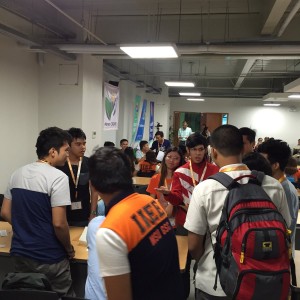
Students from different institutions and organizations interacting during the event. Photo taken from the official Twitter account of SEA Hardhat
Students from nine different universities in Mindanao convened for the Mindanao Region Inspire Conference that was held at the Community Center Training and Media Room, Ateneo de Davao University (AdDU), last Sept. 1, 2016 from 9 AM to 6 PM.
This was a one-day event which had talks on renewable energy, climate change and community development.
As explained by Sikat Solar Challenge Foundation (SSCFI) Program Manager Marites F. Timbang, the conference is Mindanao’s kick-off event for the second cycle of the Sikat Design Challenge, which will be held this year. The official kick-off started in Luzon, Quezon City last Aug. 18, 2016 and was followed by the Visayas roadshow last Aug. 25, 2016. The first cycle was held last 2014-2015.
For this cycle, 14 schools and 16 teams will be participating from Luzon, eight schools and 11 teams will be competing from Visayas and 9 schools and 14 teams will come from Mindanao. Two of the teams will come from AdDU. The winning team of the competition will receive prizes including a cash prize of Php 200,000.00 while the two runners-up will receive Php 150,000.00.
Timbang further explained that the Sikat Design Challenge is an inter-university competition focused on renewable energy targeted at the rural sectors wherein all the engineering students are called to compete so that they can develop innovative solutions on renewable energy for the communities with no electricity in the Philippines. Teams composed of five members would go to their selected community and find ways on how to address this problem.
The challenge will run for 11 months. It started this August and will commence on July 2017.
“This event was organized by the SSCFI and the whole idea is for us to promote (specifically) renewable energy among the youth. So there is no other competition in the Philippines which does this,” Timbang added.
Third year BS Electronics and Communications student Jayson Becosacer, who is also a part of one of AdDU’s teams, expressed that the whole event is relevant to the global campaign of the use of renewable energy and appropriate technology.
“I learned that everything around us can be a potential renewable energy. It is up to us to discover and think of a unique and creative way on how to utilize these energies to our advantage. The energy that we need is always there, we just need to open our mind and explore the possibilities of attaining maximum energy use while maintaining minimum environmental footprint.
“I also learned that collaboration and better communication between the participants and stakeholders towards the improvement of the community should be the core of all the future plans for the competition. Both parties should be mutual and on the same page when it comes to addressing the problem to maximize the time and effort that will be invested in the activity. After all, the main objective of the competition is not just the project but also the well-being of the community and the environment,” he shared.
Third year BS Chemical Engineering student Ruel Arila, Jr. who was able to join some of the lectures and workshops undergone by the team, said that the event was actually centered in developing a sense of nationality, cooperation, and above all, responsibility.
“There were a lot of points I’ve learned in the lecture, but perhaps the most important of those was the importance of knowing that somebody what somebody really needs before helping them. The only way for your aid to yield the maximum effect is to develop solutions that directly answer the root cause of the community’s problem,” he shared.